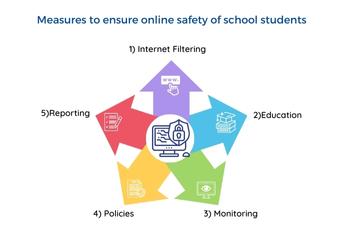The internet has revolutionized how we live our lives and has transformed the way we learn. Today, schools use the internet to give students access to information and resources that were once out of reach. However, with this increased access comes the need for increased vigilance regarding internet safety. Schools are responsible for protecting students from harmful content and online predators. This essay will examine the importance of internet safety in schools and explore policies and practices that can be implemented to ensure that students are protected from harm.
Importance of Internet Safety in SchoolsThe internet provides a wealth of educational resources that can enhance learning experiences for students. However, the internet can also expose students to harmful content, such as pornography, violence, and hate speech. Furthermore, students can be vulnerable to online predators who seek to exploit their innocence and trust. Given these risks, schools must prioritize internet safety to protect their students.
 Policies and Practices to Ensure Internet Safety in Schools
Policies and Practices to Ensure Internet Safety in Schools
Schools can implement various policies and practices to ensure students are safe online. The following are some examples of policies and practices that schools can use to promote internet safety:
1. Internet Filtering: Schools can use internet filtering software to prevent students from accessing inappropriate websites. These filters can be customized to block specific types of content, such as pornography and violence.
2. Education: Schools can educate students on internet safety, teaching them about the risks associated with the internet and how to avoid them. This education can include lessons on safe online behaviour, such as not sharing personal information online.
3. Monitoring: Schools can monitor students' online activity to ensure they are not engaging in inappropriate behaviour or accessing inappropriate content. This can be done using software that tracks internet usage.
4. Acceptable Use Policies: Schools can establish acceptable use policies that outline appropriate behaviour when using school technology. These policies can include guidelines on internet usage, such as prohibitions on accessing inappropriate content and restrictions on using personal devices.
5. Reporting: Schools can encourage students to report any instances of inappropriate online behaviour. This can include cyberbullying, online harassment, and instances of predatory behaviour.
ConclusionInternet safety is essential in schools to protect students from the potential harm of the internet. Schools can implement policies and practices to promote internet safety, such as internet filtering, education, monitoring, acceptable use policies, and reporting. By prioritizing internet safety, schools can create a safe and secure online environment for their students, allowing them to benefit fully from the educational resources that the internet provides.
References:- Ferdig, R. E., & Dawkins, M. (2017). Digital citizenship in schools. Thousand Oaks, CA: Corwin.
- Gehlbach, H., Brinkworth, M. E., & Harris, A. D. (2012). Changes in teacher–student relationships. Journal of Educational Psychology, 104(2), 351-361.
- Koehler, M. J., & Mishra, P. (2009). What is technological pedagogical content knowledge? Contemporary Issues in Technology and Teacher Education, 9(1), 60-70.
- Prensky, M. (2010). Teaching digital natives: Partnering for real learning. Thousand Oaks, CA: Corwin.
- Warschauer, M., & Matuchniak, T. (2010). New technology and digital worlds: Analyzing evidence of equity in access, use, and outcomes. Review of Research in Education, 34(1), 179-225.

